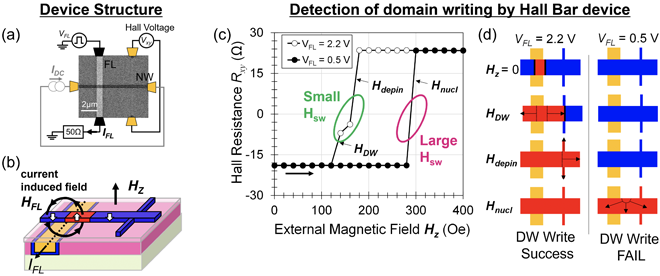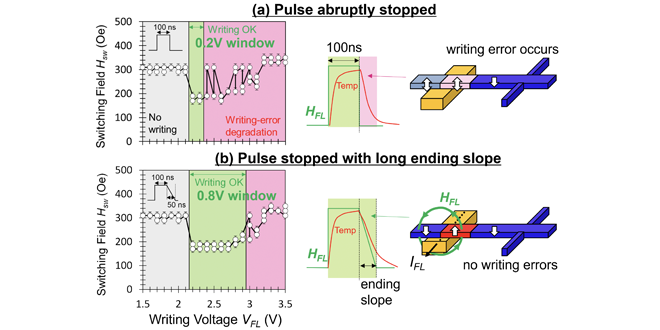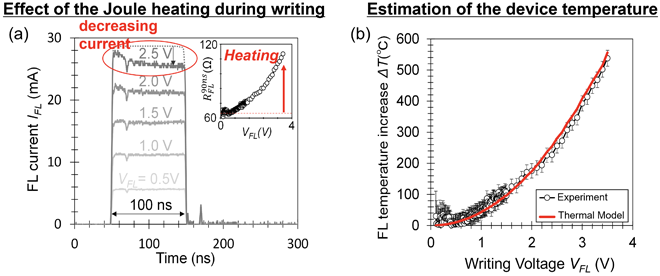Please select your location and preferred language where available.
Stable Field Writing in Magnetic Domain Wall Memory Devices by Suppression of Thermal Disturbances
January 23, 2025
The magnetic Domain Wall (DW) memory is a memory where the information is stored in arrays of small magnets aligned in magnetic nanowires (NW). Data information is stored in the small magnets (magnetic domains). Between the magnetic domains of different magnetization directions, the magnetization is twisted, and the twist is called a magnetic domain wall. Since magnetic nanowires can store multiple data in series, the write and read operations can be performed at the ends of magnetic NWs. A single magnetic NW storing hundreds of data thus requires only a few access terminals, which makes the DW memory a promising technology to enable high-capacity memory with highly packed nanowires[1].
However, since domain writing is performed by the current-induced magnetic field, write error due to Joule heating is an issue. In this report, we clarify the error mechanism in writing by the current-induced magnetic field and propose a new method, the “low-speed writing current drop method”, which enables highly reliable writing.
As shown in Figure 1(a), a writing experiment was conducted using a simple magnetic wall device formed by a magnetic NW shaped in a Hall bar geometry with an underneath wiring (FL: Field Line). When electrical current flows in the FL, it generates the writing magnetic field that writes magnetic domains with opposite magnetization directions in the magnetic NW near the FL edge, therefore forming the magnetic domain walls between the domains at the same time (Figure 1(b)). Afterward, by applying a weak external magnetic field Hz, the magnetic domains expand along with movement of the DWs.
The Hall bar detects the resistance change (the Hall resistance change) caused by the anomalous Hall effect in the magnetic material. In the case of successful writing by sufficiently large writing currents, the magnetic domain expands by the external magnetic field and the magnetization reversal occurs with response to magnetic domain wall movement. A peculiar two-step Hall resistance change is observed at a small external magnetic field and is explained by the magnetic domain wall crossing the Hall bar section (Figure 1(c) green circle). On the contrary, if the magnetic domain formation fails, no magnetic walls are formed. In this writing failure case, the whole magnetic NW undergoes a simultaneous magnetization reversal (Figure 1(d)) and a single step Hall resistance change is detected in the large external magnetic field region only ((Figure 1(d) pink circle)).

Copyright (2024) The Japan Society of Applied Physics
The writing characteristics were evaluated when the write pulse current (the current induced field HFL) drop speed was varied. As shown in Figure 2(a), when the write pulse current drop was steep, the voltage region in which stable writing occurred without write errors was limited to a narrow range. On the other hand, when the write pulse current drop was gradual (Figure 2(b)), the stable voltage region without write errors was expanded.

Copyright (2024) The Japan Society of Applied Physics
To investigate the cause of the above results, we first verified what occurred when write current is applied. As shown in Figure 3, when the write pulse voltage is applied, the decrease in write current (IFL) becomes more pronounced at higher write voltages, suggesting that the FL is heated up by Joule heating.
At the same time, the magnetic NW near the FL section is also heated up. When the write current drop is steep, the write magnetic field induced by the current (HFL) also drops steeply. Because thermal diffusion is slow, the residual heat provokes thermal disturbances to the written magnetic domains and may induce the disappearance of the magnetic domains (magnetic domain walls).
On the other hand, when the write current is gradually dropped, the magnetic domains formed are less likely to disappear because the writing magnetic field (HFL) is maintained during the cooling of the magnetic NWs. Thus, the proposed low-speed current pulse drop method allows a stable domain writing that achieves a low error rate.

Copyright (2024) The Japan Society of Applied Physics
This achievement was presented at the SSDM 2024.
Reference
[1] A. J. Annunziata et al., “Racetrack memory cell array with integrated magnetic tunnel junction readout”, IEDM 2011.
[2] M. Quinsat et al., “Stable Field Writing in Magnetic Domain Wall Memory Devices by Suppression of Thermal Disturbances”, SSDM 2024.

